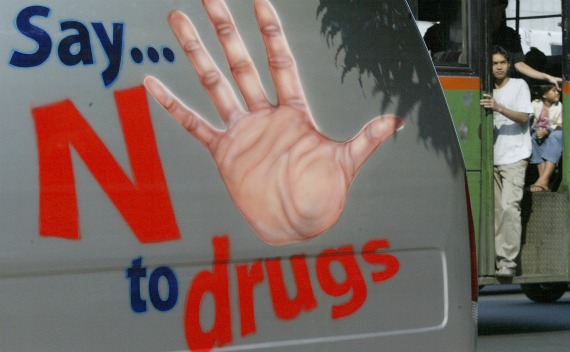Demand Side Policies in the U.S. War on Drugs
More on:

The “drug war” strategy of the last four decades revolves primarily around supply side measures. Whether eradication, interdiction, or arrests, it fixates on stopping the seemingly endless flow of drugs and cash across U.S. borders . But there is obviously another side to the equation – U.S. demand. The United States is the largest consumer of drugs across the globe (though there are signs that the cocaine and marijuana markets in Europe and the developing world are catching up) with 1 in every 7 Americans having tried an illegal substance. Marijuana accounts for the vast majority of that consumption, followed by prescription drugs and cocaine.
Three basic strategies underlie the traditional approach to dealing with drug abuse at home: prevention, treatment and enforcement. Prevention programs seek to stop substance abuse by educating primarily schoolchildren on the dangers of narcotics. Even with their memorable slogans (such as Nancy Reagan’s “Just Say No” campaign or Drug Abuse Resistance Education’s “D.A.R.E. to resist drugs and violence”) the results have been disappointing. A number of studies show these efforts – costing millions of dollars - may slightly slow marijuana experimentation among teens.
Treatment programs, particularly when focused on rehab for heavy drug users, are by far the most cost effective U.S. policy. For every million dollars spent, these programs reduce lifetime cocaine consumption by 100 grams.This may not seem like a lot, but it is more than three times as effective as preventive programs and punitive measures. Investing in treatment also yields impressive returns in terms of public safety, as every dollar spent on substance abuse rehabilitation reduces the costs of associated crime by an estimated seven dollars. Still, soaring dropout rates – even within mandatory programs -- question the long-term benefits of formal treatment for the relatively few drug addicts who choose to participate.
A final major element of demand side in the United States has been enforcement, namely incarceration of those selling and using drugs. From 1972-2002, the number of drug offenders behind bars increased twelve-fold (accounting for about half of the total growth of the federal prison population). This has hit African American communities the hardest, as 1 in every 3 black males goes to prison at some point in his life (1 in 15 black adults are currently behind bars). This is at least in part because the punishments for crack are harsher than those for powder cocaine, leading to longer sentences for black vs. white offenders. This style of stepped up enforcement doesn’t seem to have changed the fundamental drug markets, at least not for the better. Cocaine and heroin prices have hit all-time lows, indicating greater availability, while purity has increased by more than half in recent years. Methamphetamine rose from near obscurity in the early nineties to become the drug of choice for roughly 1.5 million Americans today.
Latin American officials such as presidents Felipe Calderon of Mexico and Juan Manuel Santos of Colombia are increasingly calling on the United States to do more to reduce consumption, and a recent report co-authored by former President of Brazil Fernando Henrique Cardoso urged a “paradigm shift” in global drug policy to treat “drug addiction as a health issue, reducing drug demand through educational initiatives and legally regulating rather than criminalizing cannabis.” So what should the U.S. government do?
Some experts favor legalizing narcotics, putting an end to drug war once and for all. These advocates maintain that making drugs commercially available will replace illicit markets with formal ones, and thus eliminate the violence of the illegal drug trade. Researchers have found that legalizing marijuana would not necessarily lead to a rise in substance abuse (since those that want to get high today can, at least in many states, do it quite easily), and could slash one fifth of Mexican cartels’ profits. Ending the prohibition on harder drugs may not have the same effect, as legalization could prompt more consumption of cocaine, heroin or methamphetamine (because current enforcement against these drugs is more effective than for marijuana). To appreciate the potential costs of a surge in use, one need only to look at the double-edged consequences of ending the prohibition against alcohol. While the likes of Al Capone are history, Americans today are four times more likely to abuse alcohol than all illicit drugs combined. Alcohol-abusers are also more prone to break the law, as more than half of the current prison population committed their crimes drunk.
Other experts (especially those at RAND corp.) suggest we focus our anti-drug resources on enforcement that prioritizes harm reduction. The idea here is not to lock people up indiscriminately, but to go after the most violent drug traffickers and retail dealers. While this may not alter the availability and price of drugs (current policies haven’t done this either), it would they suggest reduce the effects on the larger community and population – whether here in the United States or in places such as Mexico.
For the past three decades Washington has spent the bulk (an average of two thirds) of anti-drug resources on supply side solutions. Even as the U.S. drug control budget expanded by more than 50 percent in recent years, expenditures for demand side policies remained stagnant, growing less than one percent per year over the past decade. Realizing that there is no easy solution on either side of the border, it is time to rethink these strategies, keeping in mind the brief successes and unfortunate failures of the last four decades.
More on:
 Online Store
Online Store
